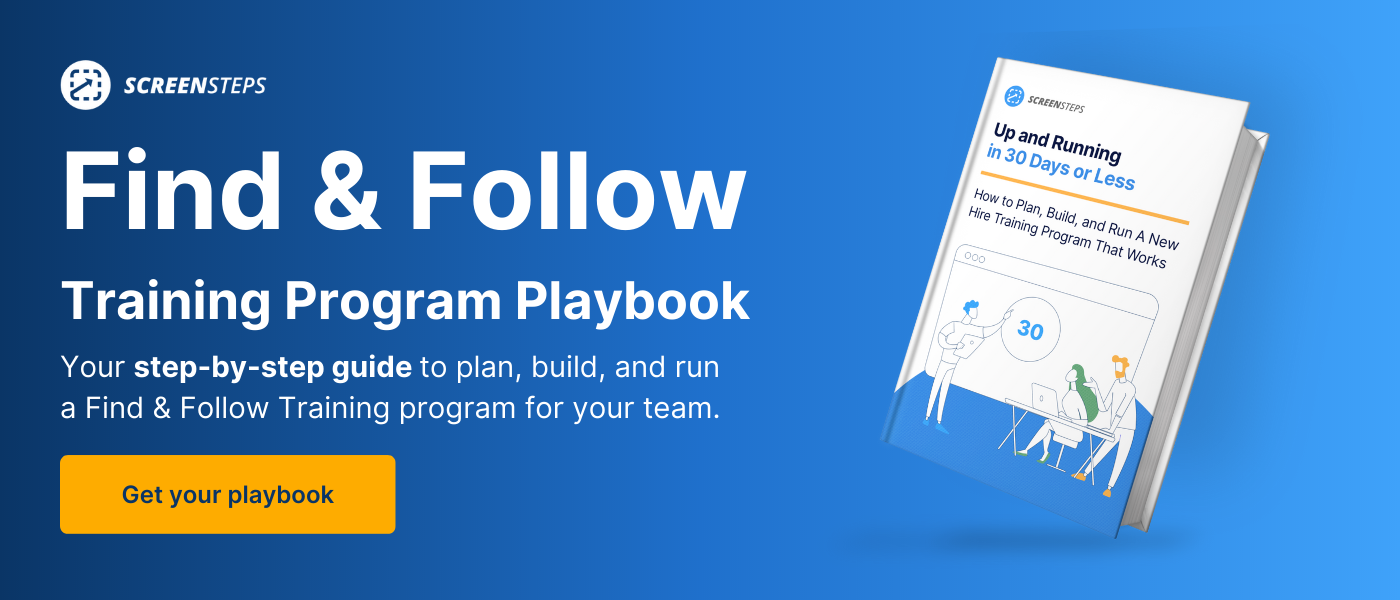How to Create a Knowledge Transfer Plan (6 Steps)
At last, you’ve identified the problem. You know why employees are making frequent mistakes, why tasks take a long time, and why performance metrics aren’t where they should be.
You have a knowledge transfer problem. Your company relies on tribal knowledge.
But not anymore! You are looking to turn things around by creating a knowledge transfer plan. The only thing is you don’t know where to get started.
Working for ScreenSteps — a knowledge ops solution — I’ve seen the benefits of having a comprehensive knowledge transfer plan. You need a clearly defined plan before you start taking action.
So, I’m going to help you get started. Follow these six steps to create a comprehensive knowledge transfer plan.
Note: These are more generic tips. If you want a more detailed plan, you’ll want to adopt specific frameworks and strategies to help you transfer and manage your company’s knowledge.
1. Research and choose the necessary software tools
When it comes to transferring knowledge, you need a centralized knowledge hub. This is a place where you can create and organize all of your information and guides.
Ideally, your knowledge hub will be easily accessible so that employees can reference the guides and lessons whenever they need support. Your knowledge hub makes it faster and easier for you to transfer knowledge from your experts to your employees.
Some knowledge hub options include:
You may also want employee training tools, like a learning management system (LMS), as part of the foundational knowledge transfer (more on that to come).
2. Identify what knowledge needs to be transferred
What knowledge do you need to transfer? Or maybe a better way to phrase this is: What do your employees need to know? Or what do your employees need to do?
Identify the specific tasks, technology, skills, etc. that your employees need to know in order to do their jobs correctly.
Tip: With ScreenSteps, we recommend companies run a Find & Follow Workshop. It helps you identify everything you need your employees to do.
3. Separate the foundational and actionable knowledge
Now that you have a list of everything your employees need to know to do their jobs, it is time to split that list in two. Separate the foundational and actionable knowledge.
Foundational knowledge is the background information that employees need to know. This is the context that employees will need to know in order to follow and understand your digital guides and other resources.
For example, industry or company-specific terms are foundational knowledge.
Actionable knowledge is the processes and procedures you need your employees to perform. It’s what you need them to do. This is usually your how-to or step-by-step articles that employees can follow to handle a task.
Why do you need to separate foundational and actionable knowledge?
A good knowledge transfer plan is comprehensive. That means that it accounts for different knowledge transfer strategies.
There are many ways to transfer knowledge, but two of the most common ways are with:
- Employee training and onboarding and
- Digital guides and other resources
When you separate your foundational and actionable knowledge, you are really creating a list of what needs to be taught during training and what needs to be documented for employee support resources.
So things you identified as foundational knowledge become your training materials for your training curriculum while your actionable knowledge becomes your digital guides.
4. Create the resources
Now that you know what your knowledge is, you can create the appropriate resources. Some of the resources you could create for your knowledge transfer plan include:
- Digital guides
- Training curriculum
- PowerPoint presentations
- On-demand video courses
- Reference sheets
This requires gathering knowledge from subject matter experts (SMEs). You can choose to have SMEs write digital guides or have a designated content creator who interviews SMEs and documents everything.
5. Transfer the knowledge
Plan how you will transfer the knowledge. Develop a training curriculum to teach your employees how to use your digital guides, on-demand training courses, or whatever other approach you decided on for transferring knowledge.
Knowledge transfer is an ongoing process, but you still need to have initial training to ensure your employees know how to access that information.
6. Evaluate and optimize knowledge transfer strategies
Once you’ve implemented your knowledge transfer plan, your work isn’t done. You’ll want to regularly evaluate how effective your knowledge transfer plan is.
Track employee performance metrics, like handle times, number of mistakes, etc. Evaluate your digital guides and keep them up to date with accurate information. Refine your training curriculum.
Tip: It helps to measure your metrics if you track base metrics before you implement your new knowledge transfer strategy.
Reduce employee mistakes and improve performance metrics
It’s challenging to figure out how to best transfer knowledge to your employees. While these steps are generic, they will help you begin creating a knowledge transfer plan.
For a more holistic approach to knowledge transfer, you’ll want to find a knowledge transfer strategy that incorporates your training and operations into one strategy. You’ll want frameworks and a strategy that seamlessly connects your software and your frameworks.
At ScreenSteps, we created the Find & Follow Framework to help companies align their training and operations teams in order to transfer knowledge more effectively.
Companies that have adopted Find & Follow have decreased training time by up to 85% while improving employee performance metrics.
Want to see if Find & Follow is the right knowledge transfer strategy for your organization?
Download our free Find & Follow playbook. This guide will provide you with steps to creating a comprehensive knowledge transfer plan for your company.




